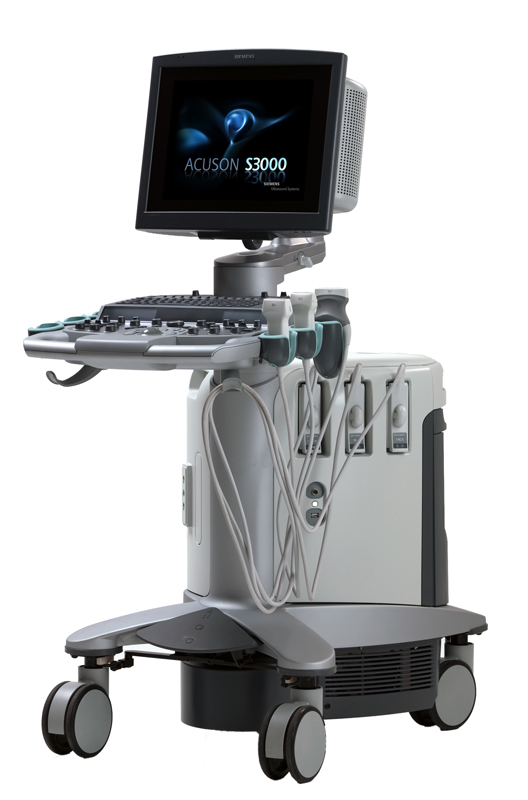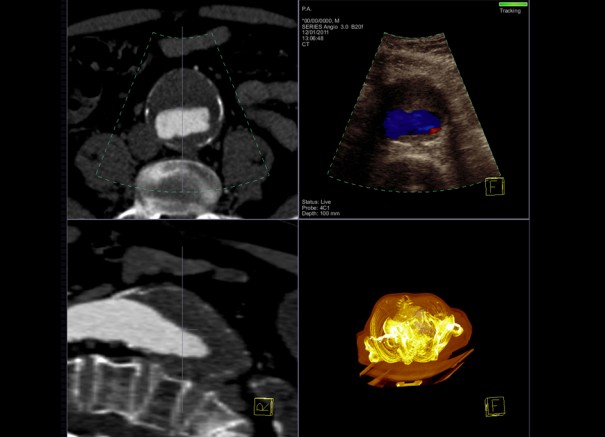El Acuson S3000 de Siemens consigue fusionar imágenes en 3D en un solo click
La empresa Siemens ha creado el dispositivo Acuson S3000 con el que se fusiona las imágenes de Tomografía Computarizada o Resonancia Magnética, con las ecografías utilizando el mapa del escáner como patrón para conocer dónde se encuentra la lesión y así hacer la punción a través de eco.
 El principal objetivo de los avances en diagnóstico por imagen es obtener una mayor calidad de imagen para poder diagnosticar cada vez con mayor precisión. In this sense, los numerosos beneficios de la fusión de imágenes de Tomografía Computarizada (TC) o Resonancia Magnética (RM) con ecografía indican que el futuro de la imagen médica pasa por la consolidación de esta técnica. Así se ha puesto de manifiesto en el XXXI Congreso de la Sociedad Española de Radiología Médica (SERAM), que se celebra en Granada.
El principal objetivo de los avances en diagnóstico por imagen es obtener una mayor calidad de imagen para poder diagnosticar cada vez con mayor precisión. In this sense, los numerosos beneficios de la fusión de imágenes de Tomografía Computarizada (TC) o Resonancia Magnética (RM) con ecografía indican que el futuro de la imagen médica pasa por la consolidación de esta técnica. Así se ha puesto de manifiesto en el XXXI Congreso de la Sociedad Española de Radiología Médica (SERAM), que se celebra en Granada.
A menudo, con una técnica primaria como el TC o la RM, es difícil diagnosticar una lesión o una patología de manera exacta. However, al sumar imágenes de diferentes técnicas, se obtiene una imagen de mayor calidad y, therefore, un diagnóstico mucho más fiable. Además de facilitar una decisión más exacta sobre la lesión o la patología, la fusión de imágenes, presenta importantes ventajas en términos de seguridad, confort y ahorro en costes al realizar una biopsia. Cuando se fusionan imágenes de TC con ecografía, se utiliza el mapa del escáner como patrón para conocer dónde se encuentra la lesión y así hacer la punción a través de eco. In this way, se evita exponer al paciente de nuevo a radiación y se reducen las listas de espera y los altos costes de pruebas como el TC o la Resonancia Magnética.
Nevertheless, las técnicas de fusión actuales requieren un registro manual de las imágenes de TC o de RM, un proceso que es lento. También se necesita que el paciente esté tumbado e inmóvil durante toda la exploración para evitar las realineaciones manuales. Para salvar estas limitaciones, Siemens Healthcare ha lanzado su última plataforma para ecografía, el equipo Acuson S3000. Este nuevo sistema de ultrasonidos representa un avance importante para este campo, en el que Siemens es pionero con su tecnología patentada eSie Fusion. Este sistema permite la fusión automática de imágenes tomográficas computarizadas (TC) en 3D con la ecografía en tiempo real con un solo click. In this way, el registro de la imagen de TC se reduce a unos segundos y se simplifican de manera significativa las técnicas de registro manual por lo que se consigue optimizar el flujo de trabajo durante el registro de volumen en la RM.
El doctor Dirk-André Clevert, profesor adjunto y jefe de sección del Centro Interdisciplinario de Ecografías del Hospital Universitario Grosshadern de Múnich (Germany), y uno de los primeros médicos que probó el sistema eSie Fusion, ha señalado que “la aplicación de la nueva tecnología de adquisición de imágenes eSie Fusion nos permite acelerar significativamente nuestro flujo de trabajo. Previously, el éxito de las intervenciones se controlaba mediante el seguimiento con TC. Nevertheless, ante la nueva solución de fusión ecográfica, sería posible reducir el número de seguimientos que deben hacerse con TC. El uso de la fusión nos permite mejorar la información clínica sin aumentar la radiación. Se trata de una gran ventaja, tanto para el paciente como para el profesional sanitario”.
Primer equipo que integra RM y PET
Siemens ha desarrollado con éxito el Biograph mMR, primer sistema de Resonancia Magnética (RM) molecular de cuerpo entero totalmente integrado con tecnología de adquisición de datos simultánea. Este sistema revolucionario se compone de un escáner de 3 Teslas y un sistema integrado de detección de tomografía por emisión de positrones (PET), con una estructura con la que funcionan como un solo equipo. El nuevo equipo Biograph mMR consigue por primera vez capturar de forma simultánea datos de RM y PET.
Esta tecnología está diseñada para aportar nuevas oportunidades para las técnicas de imagen. Mientras que la RM proporciona detalles morfológicos y funcionales precisos del tejido humano, la PET va más allá y estudia el cuerpo humano al nivel de la actividad celular y el metabolismo. Este sistema innovador tiene el potencial de ser especialmente útil para identificar las condiciones neurológicas, oncológicas y cardíacas de la enfermedad y facilitar la planificación de los tratamientos adecuados. El Biograph mMR también crea nuevas oportunidades para la investigación, como el desarrollo de nuevos biomarcadores o nuevas estrategias terapéuticas.
You liked this article?
Subscribe to our Feed And you won't miss a thing.















